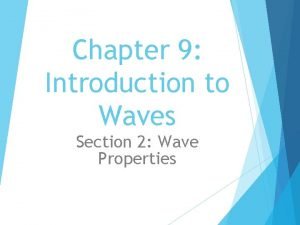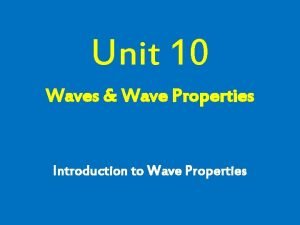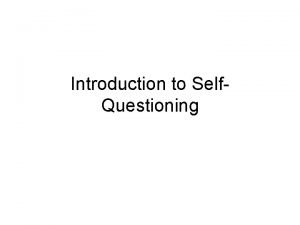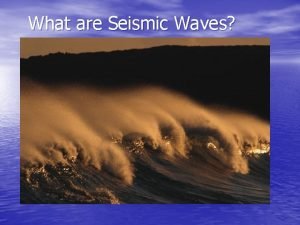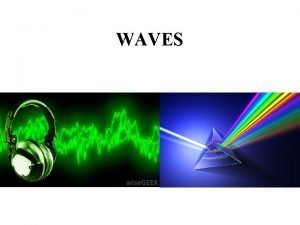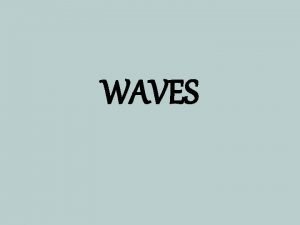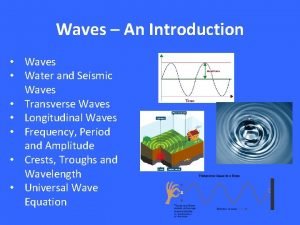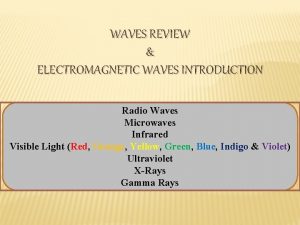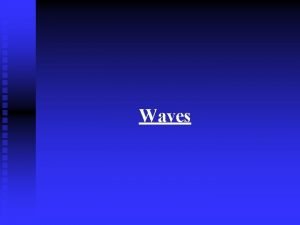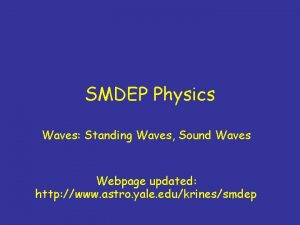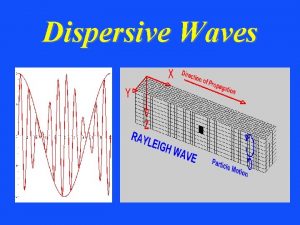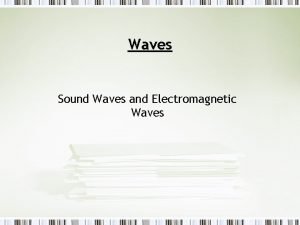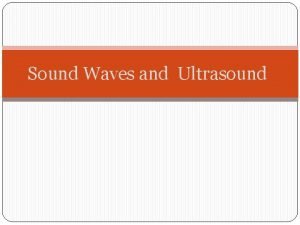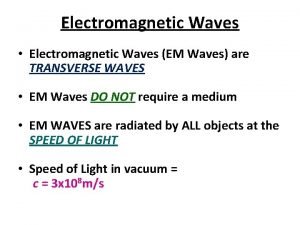INTRODUCTION TO WAVES Standard 8 P 3 Students































- Slides: 31

INTRODUCTION TO WAVES Standard 8. P. 3 Students will demonstrate an understanding of the properties and behaviors of waves. Performance Indicator 8. P. 3 A. 1: Construct explanations of the relationship between matter and energy based on the characteristics of mechanical and light waves.

LESSON OBJECTIVES By the end of the lesson, I will be able to: 1. Define a wave 2. State what waves carry 3. Define medium 4. Identify states of matter through which certain waves travel

What is a Wave? A wave is a repeating disturbance or vibration that transfers or moves energy from place to place but not matter


PROPERTIES OF A WAVE Waves are created when a source of energy (FORCE) causes a vibration. A vibration is a repeated back-and-forth or up-anddown motion. Waves carry energy through empty space or through a medium without transporting matter

PROPERTIES OF A WAVE While all waves can transmit energy through a medium, certain waves can also transmit energy through empty space. A medium is a material through which waves can travel. It can be a solid, liquid, or gas. When waves travel through a medium, the particles of the medium are carried along with the wave.

PROPERTIES OF A WAVE When there is no medium, certain waves (electromagnetic) can travel through empty space or a vacuum. * Oscillation is when a wave move or swing back and forth at a regular speed.

CHECK POINT 1. The back and forth movement of matter is called 2. A wave carries: a] energy only c] matter only b]energy and matterd] neither a nor b 3. A material through which waves can travel is called: _______ 4. Waves can carry energy through empty space or a _______ 5. What states of matter can be medium for waves?

Complete the chart below MEDIUM SOUND WAVES SEISMIC (EARTHQUAKE WAVES) OCEAN WAVES ROPE WAVES STATES OF MATTER

Introduction to waves Part 2 SWBAT State what is a mechanical wave Give 2 examples of mechanical waves. State what is an electromagnetic wave Give 2 examples electromagnetic waves.

Transverse Waves Mechanical Waves Longitudinal Waves Electromagnetic Waves Surface Waves

Mechanical Waves • Mechanical waves require the particles of the medium to vibrate in order for energy to be transferred. • Examples include ocean waves; ripples in water; seismic waves; sound, and waves along a spring or rope; wave of people at a sporting event.

Some examples of Mechanical Waves

Sound waves, as with all mechanical waves, cannot be transferred or transmitted through empty space or a (vacuum). * Mechanical waves can be either transverse or longitudinal/compressional based on how they move.

Transverse Waves • Waves in which the particles of matter in the medium vibrate by moving back and forth, up and down and perpendicular (at right angles) to the direction the wave travels. • Examples include guitar strings, waves in piano strings

Longitudinal or Compressional Waves in which the particles of matter in the medium vibrate by pushing together and moving apart parallel to the direction in which the wave travels. Each line or wave represents force/energy. Examples include sound waves, waves through fluids, liquids, gases or plasma

Check point Another name for longitudinal wave is _____. How do transverse waves move? Mechanical waves require _______ to pass. How do longitudinal waves move? True/False: Mechanical waves can travel through empty space and a medium.

Parts of a Transverse Wave The crest is the highest point on a wave.

Parts of a Transverse Wave The trough is the valley between two waves, is the lowest point.

Parts of a Transverse Wave The wavelength is the horizontal distance, either between the crests or troughs of two consecutive waves.

Parts of a Transverse Wave The amplitude is the peak (greatest) value (either positive or negative) of a wave. The distance from the undisturbed level to the trough or crest.

Parts of a Compressional Wave (Longitudinal) The compression is the part of the compressional wave where the particles are crowded together.

Parts of a Compressional Wave (Longitudinal) The rarefaction is the part of the compressional wave where the particles are spread apart.

Check point What is the lowest part of a transverse wave called? What is the highest point of a transverse wave called? The particles that are spread out in a longitudinal wave are called…… What is compression?

Electromagnetic Waves ELECTROMAGNETIC WAVES TRAVEL THROUGH EMPTY SPACE OR A VACUUM. Examples: radiation, TV & radio waves, X-rays, microwaves, lasers, energy from the sun, visible light All Electromagnetic waves are considered transverse waves because they have similar characteristics; therefore, they have the same parts.

REAL MEN IN VIRGINA UNDERSTANDS X-GIRLFRIENDS


Light waves ● Are considered electromagnetic waves which are waves that can travel through matter or EMPTY SPACE where matter is not present. ● Light waves are the only part of the electromagnetic spectrum that is VISIBLE to the human eye. ● Light waves are ELECTROMAGNETIC waves that can travel without a medium through EMPTY SPACE.

Check point True or False: Electromagnetic waves can travel through medium and empty space All of the following are examples of electromagnetic waves EXCEPT: radio waves, microwaves, sound waves, visible light Which of the following electromagnetic waves have the shortest wavelength? Gamma ray; radio or microwave


 Transverse waves move perpendicular
Transverse waves move perpendicular Longitudinal vs transverse wave
Longitudinal vs transverse wave Mechanical wave examples
Mechanical wave examples How are rainbows made
How are rainbows made Characteristics of a longitudinal wave
Characteristics of a longitudinal wave Whats a reflected sound wave
Whats a reflected sound wave What is a semiconductor used for
What is a semiconductor used for Mechanical waves and electromagnetic waves similarities
Mechanical waves and electromagnetic waves similarities Mechanical vs electromagnetic
Mechanical vs electromagnetic Mechanical waves and electromagnetic waves similarities
Mechanical waves and electromagnetic waves similarities Surface waves and body waves
Surface waves and body waves Is a seismic wave mechanical or electromagnetic
Is a seismic wave mechanical or electromagnetic Compare and contrast p waves and s waves using venn diagram
Compare and contrast p waves and s waves using venn diagram Electromagnetic and mechanical waves
Electromagnetic and mechanical waves The difference between constructive and destructive waves
The difference between constructive and destructive waves What image did rizal carved on a piece of batikuling
What image did rizal carved on a piece of batikuling Chapter 9 introduction to waves
Chapter 9 introduction to waves Which wave has the highest frequency?
Which wave has the highest frequency? Key concept builder lesson 1 what are waves answer key
Key concept builder lesson 1 what are waves answer key Peer review examples for students
Peer review examples for students Self introduction for elementary students
Self introduction for elementary students What is self questioning
What is self questioning Standard error of the mean
Standard error of the mean Power dynamics of standard language as school language
Power dynamics of standard language as school language Standard costing characteristics
Standard costing characteristics Perkembangan kurikulum sekolah menengah
Perkembangan kurikulum sekolah menengah Intro paragraph layout
Intro paragraph layout Seismic wave types
Seismic wave types Parts of the waves with label
Parts of the waves with label A repeating disturbance that transfers energy
A repeating disturbance that transfers energy Medium waves
Medium waves Electromagnetic waves vocabulary
Electromagnetic waves vocabulary
















